Refusing to evacuate, residents near a smoking Colombian volcano watch and wait
‘The danger here is falling ash and rock,’ say those who have grown up in the shadow of the Nevado del Ruiz
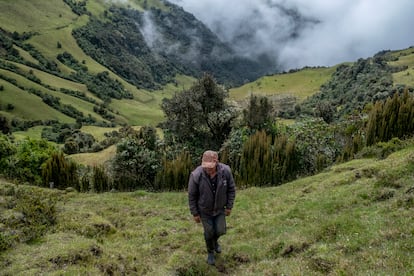
The military base at Cerro Gualí in Colombia’s Caldas Department is almost 15,000 feet (4,500 meters) above sea level. The 25 soldiers stationed there watch the Nevado del Ruiz volcano day and night. It looms over the base less than four miles (six kilometers) away, billowing a dense, white cloud of smoke that looks too perfect to be real. It would make an unforgettable postcard picture if we didn’t know that deep inside is a boiling cauldron of fire that could explode into tragedy.
At least six unblinking eyes constantly watch the volcano from various vantage points at the base, which is also an important telecommunications center. There are antennas for television, radio, cellular telephony, security forces and civil aeronautics. Voices are relayed from one end of the country to the other from this hill.
To get here, travelers must use a partially paved road that leads to Los Nevados National Park. Hundreds of tourists come every weekend to take photos in the snow and once a year, growers compete for the top prize in the national coffee tasting competition in Manizales. The area has glamping sites, dairy farms, lakes and hot springs, and a few restaurants. It’s a magnificent landscape of high-altitude moors dotted with huge gold, green and brown “frailejones” — the Espeletia shrubs that resemble a giant monk’s tonsure. The mountains are creased by colorful horizontal cracks that the locals say were left by past volcanic eruptions. But now everything within a nine-mile (15-kilometer) radius of the volcano has been shut down, and all but a few have complied with the evacuation order. The landscape looks desolate, with no visitors and no customers.
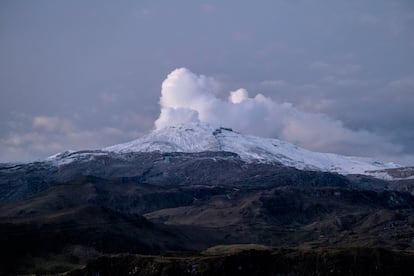
“There are no tourists — they won’t let them through. Some people who live nearby come, but no tourists at all,” said Angie Lorena Suárez, whose small store sells warm clothing for the mountains, sweets and coffee. She said she opened her shop this week “so people don’t see everything all closed up.” The only people passing through are road maintenance workers and some local farmers transporting potatoes and cattle.
About a month ago, an emergency alert was issued, and most residents evacuated the area. “We’re sad that many of our neighbors have left — about 15 of them — because they were afraid,” said Santiago Pineda.
Pineda and his wife, Carolina Morales, run a farm that produces 1,000 liters of milk a day. The cows are milked twice a day by the six families working there who have a special attachment to this land. Even if they wanted to leave, they have nowhere to go. “We love this farm very much because we grew up here. How can we leave everything behind?” Carolina asks as she kneads arepa dough made of freshly ground cornmeal. Carolina puts a pot of water on the stove to make “agua de panela,” a sugar cane drink. “We’re on the lookout here for falling ash and rocks because we’ve felt a lot of tremors. Last night, our stomachs knotted up again. But we’re not afraid. What are we going to do — leave? And go where? Maybe, if they gave us some help, but no. It’s better to stay in our little house, our own house,” she said.
Carolina and Santiago have two children. A schoolteacher regularly delivers schoolwork to 10-year-old Carol and gives her virtual classes by video once a week. Their son, Matías, is only four and not in school yet. There are about 20 children in the area, but not all of them have internet connections for the virtual classes or parents with enough time to help them study. “Some parents don’t have time because they’re milking cows or working in the potato fields. And moms like me are always in the kitchen cooking for the workers. We don’t have time either,” said Carolina.
Everyone we talked to loves the imposing but beautiful volcano. They have lived near it all their lives and say they know how to read its moods. They are accustomed to its roars and smoke plumes, its color changes and angry threats, like the one happening now. But no one denies this time is different — it’s more than just a few tremors.
Don Leo, a good-natured and talkative old man in his seventies who has lived in these parts for over 50 years, says even the climate is different these days. “It has changed a lot. There are some very strong hurricanes lately; winds that we didn’t have before,” he said. “The weather is warmer, not chilly like it used to be. It’s a warning of sorts.”
Leonardo Ortiz lives high in the mountains near the military base, almost 15,000 feet (4,200 meters) above sea level. He is the custodian of the Caracol and RCN broadcast television network antennas and keeps a makeshift volcano museum. “We’re friends,” he said. “You have to fear it — you have to fear nature. It must be respected. But you also have to trust it. The danger here is not an avalanche but falling ash and rock [from an eruption],” he said, assuring us he has a place to take shelter.
Ortiz knows what an eruption is like because he lived through one in 1985. “We didn’t see the avalanche coming because it was nighttime, but we felt it. We felt something huge coming down. We felt the vibration. We were shocked to see it all the next day. Everything was destroyed — roads, bridges, everything.” He lives alone on the mountain during the week and goes back to Manizales to see his family on the weekends. Nearby is the army’s mobile radio station, a basic facility that broadcasts music, news and emergency alerts to the area. The army has distributed 200 radios locally so people can tune in and stay informed.
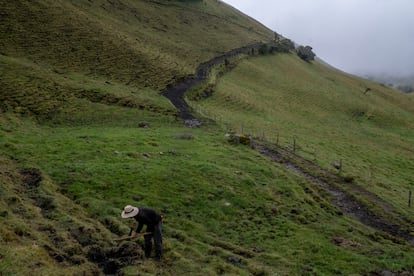
On the other side of the volcano, a military man walks along a dirt road in the Papayal community with a megaphone, making announcements that echo around the mountains. “The National Army is informing you of the protective measures you should take if volcanic ash falls. Avoid using contact lenses that can cause eye irritation. Cover your food and water cisterns. Clean ash from gutters and roofs. Stay at home with doors and windows closed as much as possible. If you have to go out, use a mask or a moist handkerchief over your nose and mouth…”
Papayal is within nine miles (15 kilometers) of the crater and no one should be there anymore. But the people who stayed have no intention of leaving. It’s where they have roots and lives. It’s the only future they can imagine. They’re convinced that this will be no different from the many other times they have seen their volcano get angry.
To get to the operations center at the top of the military base, one must climb 200 steep cement steps. The air is thin, and we have to make frequent rest stops. Hot chocolate at the top revives our flagging energies.
The operations center has all the basics: a kitchen with enough food for several weeks and an infirmary with oxygen tanks. Altitude sickness is part of daily life. Reinforced rooms can be used as bunkers to shelter in, and trenches shield people outside from the wind and cold. The center is equipped with oxygen masks and helmets to protect against falling ash and rock. There are radios and antennas, maps, and real-time displays of volcanic activity from the Colombian Geological Service. The 25 men stationed there are focused on their mission: alerting the nation to an eruption.
Since the operations center is opposite the Nevado del Ruiz, there’s no risk of being buried by an avalanche. The danger for these soldiers comes from pyroclastic material: hot lava chunks, pumice, ash and volcanic gas — everything that can spew from the depths of the Earth. They appear calm, but are always on alert. The soldiers are grateful for our visit — we’re the first journalists to report on their emergency preparations. I hope we don’t have to return, I tell them. Because if we do, it’s because there’s bad news that nobody wants to hear.
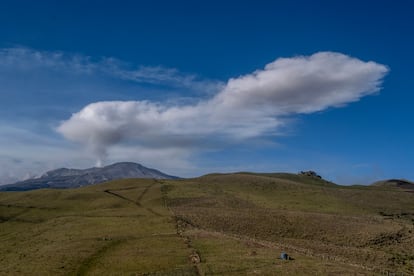
Sign up for our weekly newsletter to get more English-language news coverage from EL PAÍS USA Edition
Tu suscripción se está usando en otro dispositivo
¿Quieres añadir otro usuario a tu suscripción?
Si continúas leyendo en este dispositivo, no se podrá leer en el otro.
FlechaTu suscripción se está usando en otro dispositivo y solo puedes acceder a EL PAÍS desde un dispositivo a la vez.
Si quieres compartir tu cuenta, cambia tu suscripción a la modalidad Premium, así podrás añadir otro usuario. Cada uno accederá con su propia cuenta de email, lo que os permitirá personalizar vuestra experiencia en EL PAÍS.
¿Tienes una suscripción de empresa? Accede aquí para contratar más cuentas.
En el caso de no saber quién está usando tu cuenta, te recomendamos cambiar tu contraseña aquí.
Si decides continuar compartiendo tu cuenta, este mensaje se mostrará en tu dispositivo y en el de la otra persona que está usando tu cuenta de forma indefinida, afectando a tu experiencia de lectura. Puedes consultar aquí los términos y condiciones de la suscripción digital.
More information
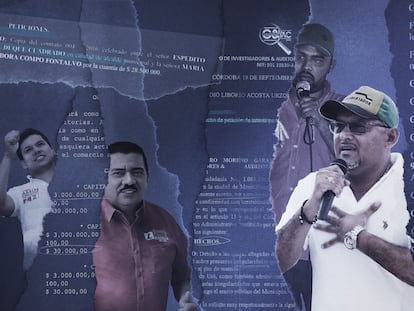
Assassination of journalist Rafael Moreno: Revealing the millions embezzled in Colombia
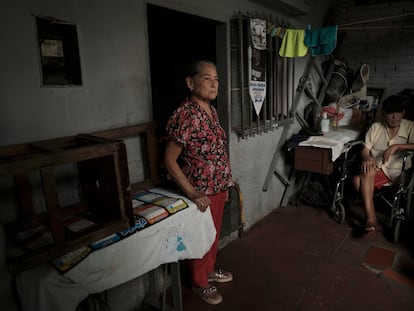
Forced disappearances plague the Colombia-Venezuela border
Archived In
Últimas noticias
Most viewed
- Reinhard Genzel, Nobel laureate in physics: ‘One-minute videos will never give you the truth’
- Oona Chaplin: ‘I told James Cameron that I was living in a treehouse and starting a permaculture project with a friend’
- Pablo Escobar’s hippos: A serious environmental problem, 40 years on
- Chevy Chase, the beloved comedian who was a monster off camera: ‘Not everyone hated him, just the people who’ve worked with him’
- Why we lost the habit of sleeping in two segments and how that changed our sense of time








































